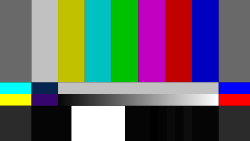Color Bars
 Cast: (clockwise, from upper left) White, Yellow, Cyan, Green, Magenta, Red, Blue, Black, Purple. | |
| Genre: | Sitcom |
|---|---|
| Opening Theme: | Sinusoidal 1 kHz |
| Produced by: | Woody Allen |
| Country of Origin: | America |
| Language: | English, Japanese, American |
| Budget: | £9,000,000/Season |
| Number of Seasons: | 35 |
| Number of Episodes: | 530 |
Color Bars is a popular long-running television series. It has been praised for its engaging storyline and multiracial cast. The story follows the misadventures of the protagonist (White) in his quest to find his place in the world while raising his 7 children with his wife, Green.
The series is often aired between the hours of 2 AM and 6 AM on most major networks.
Cast and Characters[edit | edit source]
Note: all cast members play themselves in the series.
White[edit | edit source]
Often has disagreements with his cousin Yellow, whom he sees as not quite "white" enough. Despite their differences, White grows extremely close to the family, even turning down his mother (Cyan) when she offers to let him move back in with her again in Harlem.
Yellow[edit | edit source]
The successful cousin of White, he is a businessman in South Korea and during most of Season 1 and 2 he is under the influence of marijuana.
Cyan[edit | edit source]
The mother of White, a stereotypical Jewish Mother. She is a firmly conservative Republican, and proves both friend and foe for White.
Green[edit | edit source]
The wife of White, whom he met at a hotel in the winter during a snow storm. Bore White's seven children.
Magenta[edit | edit source]
A hooker that often provides comic relief in the series. First met White in episode 4 when his car broke down and later (in episode 204) is revealed to be White's grandmother.
Red[edit | edit source]
The well-meaning father of White who often gets in trouble with the cops. A Korean war veteran himself, he is often heard reminiscing his time spent in the war and teaching White's kids life-lessons.
Blue[edit | edit source]
White's gay roommate from college who lives with White's parents, Cyan and Red. Runs a laundromat across the street and often feuds with Yellow.
Purple[edit | edit source]
White's sister. Practices Satanism and Wicca and is often seen in a grumpy mood. Does not like children and often scares White and Green's kids.
Black[edit | edit source]
The nigger of the show who just can't seem to catch a brake, he is constantly looking for a job( and getting it) but losses his jobs due to funny circumstances. The group never pays attention to him or is even aware of his existence due to them always walking on him even though he has saved the life of White at least twice in every episode.
Little Blue, Little Magenta, Little Cyan, Little White, and Little Black x3[edit | edit source]
White and Green's seven children.
Reception[edit | edit source]
Praised for its exceedingly realistic graphics and artistic usage of still images to portray complex issues on global interrelationships and quantum electrodynamics, this show has been watched by everyone. This show is so popular that it will interrupt any show on TV whenever a new episode comes out. Indeed, this show is so powerful that anyone who sits through an entire episode will sympathize with the main characters by feeling great amounts of pain and suffering to the ear, the eyes, and eventually the brain. You would have to be made of stone not to feel anything as you are hypnotised by the monotonic theme music and bright colours.
Some people claim that this is not a show, and instead will switch channels immediately. However, these people are simply ignorant about daily issues threatening mankind, and are deemed "normal people". Poor reception of the show in the distant past was primarily attributed to weak signal strength and bent antennas.
S2:Philips PM 5544's Gun[edit | edit source]
A new friend is called Philips PM5544, Philips hates UEIT but fucking serious with a shawm, Philips PM5544's destination is in here in Dnipropetrovsk
Digital Television[edit | edit source]
In 2009, the arrival of digital television mostly fazed out Color Bars, replacing it instead with what some TV engineers referred to as "more stable shows", such as House, Friends, and Lost.

